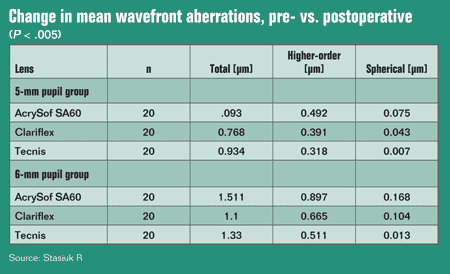Higher-order aberrations reduced in large pupils with aspheric IOL
The aspheric quality of the Tecnis resulted in better vision in both 5-mm and 6-mm pupils compared with two other lenses.
|
|
An IOL that compensates for the natural spherical aberration of the cornea significantly reduces the amount of postoperative higher-order aberrations in eyes with large pupils compared to standard lenses, according to one surgeon.
Ron Stasiuk, MD, performed a study comparing Alcon’s AcrySof SA60 acrylic IOL and Advanced Medical Optics’ silicone ClariFlex and Tecnis lenses. The Tecnis outperformed the other two IOLs in both 5-mm and 6-mm pupil groups in terms of induced higher-order and spherical aberrations, he said. Dr. Stasiuk presented the data at the American Society of Cataract and Refractive Surgery meeting in Washington and the Australasian Society of Cataract and Refractive Surgeons meeting in Queenstown, New Zealand.
The Tecnis lens features a wavefront-designed aspheric surface that compensates for the cornea’s spherical aberration, he said. This differentiates it from the other two lenses.
HOA comparisons
Dr. Stasiuk performed cataract surgery in 60 eyes. He divided the eyes into three groups of 20, with each group receiving one type of lens. Pre- and postoperative higher-order aberrations were measured using Shack-Hartmann aberrometry. The same eyes were studied in both 5-mm and 6-mm pupil groups, and measurements were statistically calculated.
“When the pupil is larger, the quality of vision or higher-order aberrations increase significantly, so comparisons are more significant statistically,” Dr. Stasiuk told Ocular Surgery News.
According to his results for both groups, the Tecnis lens induced fewer higher-order and spherical aberrations than the ClariFlex and the SA60 lenses. The differences were statistically significant. (Table.)

Focus on HOAs
Increasingly, ophthalmologists are focusing on the eye as it ages and the lens becomes characterized by increasing positive spherical aberration, Dr. Stasiuk said. Total wavefront aberrations increase threefold between the ages of 20 and 70.
Theoretically, he said that maximum human visual acuity is 20/5 based on the density of receptor cones at the fovea, but due to factors such as higher-order aberration, the best vision a person can achieve is 20/8. The diffraction limit for 2-mm pupils is 20/8. Above 2 mm, pupil diffraction has no role in limiting vision, only optical aberrations, he explained.
“Such good vision is more likely to be obtained if a patient has an IOL with minimum HOAs such as the Tecnis IOL,” he said.
For Your Information:
- Ron Stasiuk, MD, can be reached at Vision Group, Blackburn South Eye Clinic, 156 Canterbury Road, Blackburn South, VIC 3130, Australia; +61-3-9877-6288; fax: +61-3-9822-0519; e-mail: ggrayfre@bigpond.net.au. Dr. Stasiuk is a consultant for AMO.
- Advanced Medical Optics, manufacturer of the ClariFlex and Tecnis lenses, can be reached at 1700 E. St. Andrew Place, Santa Ana, CA 92705 U.S.A.; +1-714-247-8200;. Alcon, maker of the AcrySof SA60 lens, can be reached at 6201 South Freeway, Fort Worth, TX 76134 U.S.A.; +1-817-293-0450.
- Jared Schultz is an OSN Staff Writer who covers all aspects of ophthalmology. He focuses geographically on Europe and the Asia-Pacific region.

![Ron Stasiuk, MD [photo]](/~/media/images/news/print/ocular-surgery-news-europe-asia-edition/2006/02_february/stasiuk_70_90_6157.jpg)